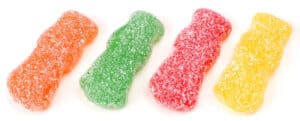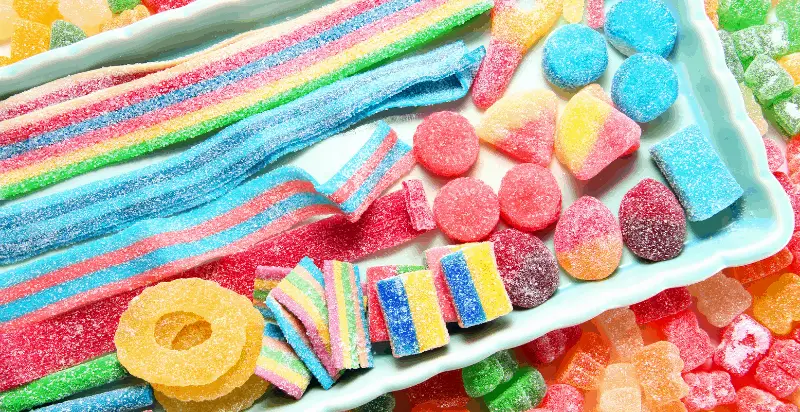Last Updated on April 29, 2021 by Jim Edwards
If you love sour candy, you know that mouth puckering sour flavor that you love! If you’re like most of us, at some point you have wondered about what ingredients make the sour candy taste sour, right? We all have. Some readers asked us and we wrote this article to explain why sour candy tastes sour, the specific ingredients and how they are used.
By the way, some of our favorite extremely sour candies we have written about include: Sour Patch Kids, Jolly Rancher Sour Surge, and Toxic Waste Candy.
Contents
How is Sour Candy Made?
Most sour candy is manufactured using a fruit based recipe that is heated and to precise temperatures and cooled on specific timeframes. These very technical heating and cooling processes impact the molecular structure of the fruit and sugars and affect the hardness or softness of the candy.
And if the candy is chewy, as many sour candies are, they typically contain gelatin along with some version of “sour sugar” to give them their typical appearance, consistency, chewiness, and sour flavor.
What Causes the Sour Flavor in Sour Candies?
In brief, sour candies use different types of acids that create a sour taste in your mouth. Each of the acids provides a different level of sourness when added to a candy. These acids have high pH levels and the higher the pH level, the more sour the candy tastes.
Without boring you with too much chemistry, let us give you a quick summary, so you can sound smart with your friends next time you are eating some sour candy. The pH scale ranges from 1-14. Water is a pH of 7, so it sits in the middle of the scale. A pH value below this is more acidic (higher in acid) and a pH value above this is less acidic (lower in acid).
The strong acids mentioned below have a pH of 1 to 2. Most sour candy has a pH in the range of 1 to 3, depending on its range from a mere “tart” to “insanely sour.”
Let’s review them in more depth…
The Main Acids that Cause the Sour Flavor
Five of the most common acids used in sour candy include citric acid, malic acid, fumaric acid, and tartaric acid. There are other flavors and compounds but these are the main acids.
Citric Acid
Citric acid is commonly found in citrus fruits like limes, lemons, grapefruits. Most sour candies use these fruit flavor profiles in their recipes and flavors.
Ascorbic Acid
Everyone knows ascorbic acid as Vitamin C, something that is found in citrus fruits like oranges.
Malic Acid
This is the super sour acid that provides the extreme sour flavor of candies like Warheads or Toxic Waste Candy. This is an organic compound found naturally in fruits like Granny Smith apples, apricots, or cherries. When used in sour candy, it is added to provide even more intense flavor. The magic acid is usually coated in palm oil during the candy making process. This prolongs the tartness of the candy – as the oil melts in your mouth slowly, it releases the malic acid over an extended period of time.
Fumaric Acid
Some scientists think this is the strongest and most sour-tasting acid because it has low dissolvability. Which means it takes a longer time to dissever and that is what makes the sour taste super long lasting.
And this is a naturally occurring compound in small amounts in apples, beans and carrots.
Tartaric Acid
Tartaric acid is more astringent than the other sour organic acids. It adds that tart and astringent sour flavor.
It is found in cream of tarter, baking powder, wine, grapes and even bananas.
Other ingredients in Sour Candy
Typical ingredients include sugar, fruit (or fruit flavors), corn syrup, Gelatin (for gummy and jelly candy) and palm oils.
Last thing we should mention is…
Sour Sanding (aka “Sour Sugar”)
If you’ve ever enjoyed sour gummy bears like the ones shown below, candy makers refer to sour sanding, or sour sugar as a food ingredient they use to make the sour flavor. It is a way to blend the acids mentioned above (typically a blend of citric/tartaric acid) with sugar to make a coating for the exterior. This is the exterior sugary and sour coating on the outside of Sour Patch Kids like you can see in the picture below. And also the same candy manufacturing process used in hard candy like SweetTarts.

And Finally, a Warning!
Health Hazards of Eating Too Much Sour Candy
Wait, what? Sadly there are downsides. Personally I had some issues. For a period of time I was basically BINGING on sour candy. And then I went to the dentist…and I had SIX CAVITIES!!
The two things that are important to know, are that eating sour candies can irritate your tongue and cause irreversible dental erosion. The acids in the sour candy can break down the dentin and enamel, which are the protective coverings on your teeth. So just be careful not to overdo it, make sure you brush with your teeth, and if you are really concerned discuss with your dentist. We have included some medical scientific references below.
References
Robyn, R. Loewen; Robert, J. Marolt; John, D. Ruby (Mar–Apr 2008). “Pucker up: the effects of sour candy on your patients’ oral health. A review of the dental erosion literature and pH values for popular candies”. Northwest Dentistry. 87 (2): 20–21, 24–25, 28–29 passim. ISSN0029-2915. PMID18491469.
“Delivering better oral health: an evidence-based toolkit for prevention”(PDF). Public Health England. June 2014.
Image Credit for Sour Patch Kids: Evan-Amos, CC0, via Wikimedia Commons
Video: This is What Makes Candy Sour
If you want to see the sour candy manufacturing process and learn even more about it, this video is worth a watch. It will show you how the acids mentioned above are blended in the manufacturing process.
I’m Jim Edwards and I started this website to share my love of Junk Food. We cover new junk food, desserts, snack foods, fast food secret menus, candy (of course!) and other related news. We love trying “secret menus” at restaurants. And we love trying new products too. So, we are trying to have some fun with our hobby and share some useful information with you, our community. Please feel to send us your suggestions and feedback through the contact form. And if you have products you would like us to try, let us know…!

